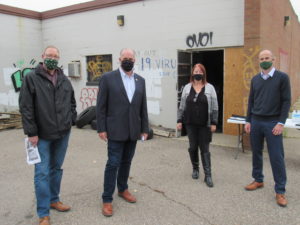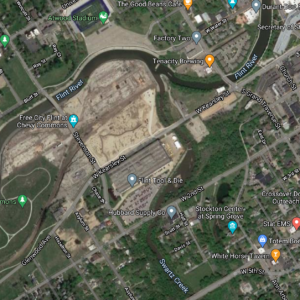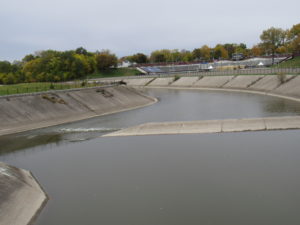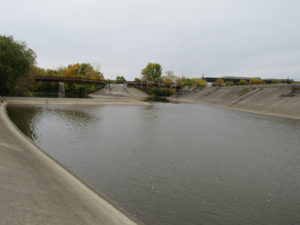By Harold C. Ford
“Sometimes it’s the use of land, not for commercial purposes, that has the greatest value.”
–U.S. Rep.Dan Kildee, (MI-5th District), in a statement to East Village Magazine, Oct. 14, 2020
A restoration project on the peninsula where the Flint River meets Swartz Creek — the “Flint River-Swartz Creek Confluence” — was announced Oct. 14 by representatives of organizations sponsoring the project at an event hosted by the Flint River Watershed Coalition (FRWC).
The “Flint River-Swartz Creek Confluence” is an approximate 2.5-acre triangular patch of land bordered on the south by W. Kearsley Street, projecting northward to a peninsula bordered on the west by Swartz Creek and on the east by the Flint River.
$1 million+ project
According to Rebecca Fedewa, FRWC executive director, the first stages of the project are projected to cost nearly $1 million.
Thus far, $500,000 has been secured from the Environmental Protection Agency’s (EPA) Great Lakes Restoration Initiative (GLRI) for development of the Swartz Creek side of the peninsula. Initial plans call for the following:
- Infrastructure upgrades to include drainage systems (storm water sewers, catch basins, culverts), new sidewalks, outfall rehabilitation (at the shoreline), driveway access and parking spaces for automobiles;
- Visitor-friendly amenities such as scenic overlooks, interpretive signs, shaded seating, benches, and an ADA (Americans with Disabilities Act) access ramp;
- Greening projects consisting of bioretention systems to remove contaminants from storm water runoff, tree plantings, and landscaping;
- Accessibility to the water.
A grant-writing/application process already is underway to secure the projected $485,000 cost for development of the Flint River side. Plans call for similar developments on the Flint River side of the peninsula including kayak/canoe launch sites and a truck/trailer staging area, Fedewa said.
The now-abandoned and dilapidated Serval Building at 630 W. Kearsley St., along with its adjoining driveway and parking lot, are also targeted for upgrades pending additional sources of funding.

Standing in front of abandoned Serval Building, 630 W. Kearsley St., Flint, MI (l-r) Doug Schultz, FRWC board chairman; Dan Kildee, U.S. Representative, 5th Congressional District; Rebecca Fedewa, FRWC executive director; Scot Lautzenheiser, Wade Trim project manager/landscape architect. Photo by HC Ford
Fedewa said the goal was a “major rehabilitation to turn this whole 2.5 acres from what you see now—blighted and abandoned—and turn it into a hub of activity right outside of downtown Flint.”
“Once this piece is done, it ties into all of the investments that have happened at Chevy Commons…and the future work that’s slated through downtown to improve the accessibility of…the river (Flint River) through downtown Flint,” Fedewa said.
Accessibility
Currently, there are only two access sites located within the city to the Flint River for kayaks and canoes — at the Mott Park Recreation Area (MPRA) and at Vietnam Veterans Park.
The MPRA roughly includes what used to be the Mott Park Golf Course, sandwiched between Nolen Drive and the Flint River. Kettering University and McLaren Hospital are nearby.

The access site at Vietnam Veterans Park, located near the intersection of E. Hamilton Ave. and James P. Cole Blvd., is shortly upriver from the Hamilton Dam. That usually means kayakers and canoeists decide to paddle upriver as the dam would short-circuit a downriver trip.
“There aren’t any other great locations where people can get in and use the river recreationally,” Fedewa said.
Spring 2021 is possible start date for project with federal funds
“There’s funding available right now from the EPA’s GLRI to do storm water improvements on the Swartz Creek side,” Fedewa said. Work may begin in the spring of 2021, she said.
“(GLRI) is a source of some of the funds that has been used for various aspects of this work,” confirmed U.S. Rep. Dan Kildee, whose 5th Congressional District includes Genesee County and the City of Flint, in an interview with EVM.

Flint River-Swartz Creek Confluence: Flint River front/right meets Swartz Creek on the left; Atwood Stadium in the background; view from the south. (Photo by HC Ford)
Using his position as Chief Deputy Whip in the U.S. House, Kildee helped secure $335 million for the GLRI in recent appropriations bills passed by the House. “Each year that I’ve been in Congress there’s been an attempt to cut it (GLRI funding),” said Kildee. “Last year, in fact, President Trump essentially proposed the full elimination of GLRI.” He indicated that GLRI has survived due to bipartisan support.
“Too often, the calculation is that if we make an investment, there will be some immediate commercial value, when we don’t live our lives as commercial beings,” Kildee reflected. “We’re human beings, and we ought to be able to think about the quality of the lives that we lead and think about what this would mean.”
“The money’s there,” Kildee asserted. “The question is if we’re going to use it for weapons of destruction, or to rebuild the earth. We have a stake in that and we ought to invest in it.”
Reclamation of “a really cool spot”
“I’m a Flintstone, born and raised here all of my 62 years,” Kildee reminisced. He said he’d driven by the site of the proposed development on W. Kearsley Street a “thousand times…but I’d never been out to that point, and when I stood there, I said, ‘Wow, this is a really cool spot…It just begs for someone to help restore it so it can be an asset for people who live here.’”

Flint River-Swartz Creed Confluence: view from the north; Flint River on the left; Swartz Creek on the right. (Photo by HC Ford)
“This is a way for us to reclaim the river as a natural asset,” said Kildee. “For too many decades, too many cities treated rivers like open sewers and they are, and can be, really beautiful assets that people are naturally drawn to…With a little bit of help, nature has found a way to take that back, and that’s what I see happening here.”
“When you walk out onto the point,” Fedewa said, “You really get a sense of how everything ties together and how great an amenity this will be for all the residents in Flint.”
A video presentation of The Flint River can be viewed here.
EVM Staff Writer Harold C. Ford can be reached at hcford1185@gmail.com.



You must be logged in to post a comment.